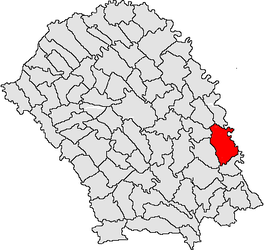Ștefănești, Botoșani
Appearance
This article needs additional citations for verification. (January 2011) |
Ștefănești | |
|---|---|
 Location in Botoșani County | |
| Coordinates: 47°47′29″N 27°11′57″E / 47.79139°N 27.19917°E | |
| Country | Romania |
| County | Botoșani |
| Government | |
| • Mayor | Florin Buțura[1] (PNL) |
| Area | 96.58 km2 (37.29 sq mi) |
| Population (2021-12-01)[2] | 5,032 |
| • Density | 52/km2 (130/sq mi) |
| Time zone | EET/EEST (UTC+2/+3) |
| Vehicle reg. | BT |
Ștefănești (Yiddish: שטעפנשט, Template:Lang-he-n) is a small town in Botoșani County, Western Moldavia, Romania. It administers four villages: Bădiuți, Bobulești, Stânca and Ștefănești-Sat.
The painter Ștefan Luchian (1868–1916) was born here, as well as Vlad Onicescu, the father of the mathematician Octav Onicescu (1892–1983). The town is also the birthplace of the Shtefanesht Hasidic dynasty and as such its name is still known in present-day Israel.
Stânca is a border checkpoint to Moldova.
Demographics
According to the census from 2011 there was a total population of 5,092 people living in this town. Of this population, 90.57% are ethnic Romanians, 9.3% ethnic Romani.[3]
References
Wikimedia Commons has media related to Ștefănești, Botoșani.
- ^ "Results of the 2016 local elections". Central Electoral Bureau. Retrieved 3 April 2020.
- ^ "Populaţia rezidentă după grupa de vârstă, pe județe și municipii, orașe, comune, la 1 decembrie 2021" (XLS). National Institute of Statistics.
- ^ "Structura Etno-demografică a României". Edrc.ro. Retrieved 8 October 2017.



